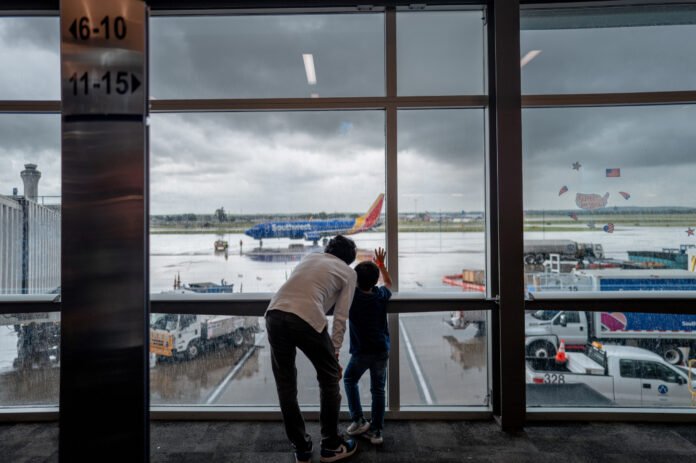A record-breaking 72.2 million Americans are traveling for the Fourth of July holiday this year. Still, severe weather, extreme heat, and wildfire risks are threatening to derail plans across the country. According to the National Weather Service and multiple travel agencies, storms are sweeping through the Northeast, Midwest, and Southeast, while heat advisories and red flag warnings are in effect in parts of the Plains and West.
The Federal Aviation Administration (FAA) has issued ground stops at major airports, including Newark, LaGuardia, and Boston, this week. At the same time, the Transportation Security Administration (TSA) expects to screen over 18.5 million air travelers between July 1 and July 7. Meanwhile, road congestion is peaking, with INRIX warning of heavy traffic through Friday afternoon.

Brandon Bell/Getty Images
The Context
This year’s Independence Day travel surge is the largest in U.S. history, driven by the holiday coinciding with a Friday and pent-up demand for summer getaways. However, the convergence of volatile weather and record crowds is creating one of the most challenging travel environments in recent memory. Flight delays, cancellations, and dangerous driving conditions could impact millions.
What To Know
Severe thunderstorms on July 3 caused ground stops at LaGuardia, Newark, and Boston Logan airports. As of Thursday evening, over 600 flights were canceled, and nearly 2,000 were delayed nationwide. The FAA warns that delays may continue into the weekend, especially in Florida and the Carolinas.
TSA Administrator Ha Nguyen McNeill said the agency is fully staffed but warned travelers to “pack their patience.”
Travelers without a Real ID should expect additional screening and longer wait times.
Temperatures are 10–20°F above average in parts of Minnesota, Wisconsin, and the Great Lakes region. Cities like Chicago, Detroit, and Burlington are under heat alerts, with highs in the 90s and heat indexes near 100°F.
Red flag warnings are in effect in Oregon, Idaho, Nevada, and Utah due to dry conditions and high winds. Wildfires have already sparked in parts of California, prompting local evacuations and the banning of fireworks.
The National Hurricane Center is monitoring a disturbance near Florida that could bring heavy rain and flooding through the weekend. Even without development, tropical moisture is expected to drench much of the state, especially on July 4.
AAA projects 61.6 million Americans will travel by car this week. INRIX recommends driving early in the morning to avoid peak congestion, which is expected from noon to 7 p.m. on July 4.
What People Are Saying
The NWS weather prediction center said on X, formerly Twitter, on Wednesday: “Hazardous heat is forecast across the Midwest and Great Lakes regions July 4-6. Heat index values are expected to reach 90-100 degrees. If you will be outdoors, be sure to hydrate and take breaks!”
The NWS also said on X on Friday: “Heat and humidity will be migrating eastwards across the Great Lakes region towards the East Coast through the Holiday weekend, with notable population centers entering the Major Heat Risk category.”
What Happens Next
Storms are expected to clear in the Northeast by Friday evening, offering better conditions for fireworks and outdoor events. However, Florida and parts of the Southeast are expected to continue seeing rain through the weekend. Travelers are advised to closely monitor weather alerts and transportation updates for the most up-to-date information.






